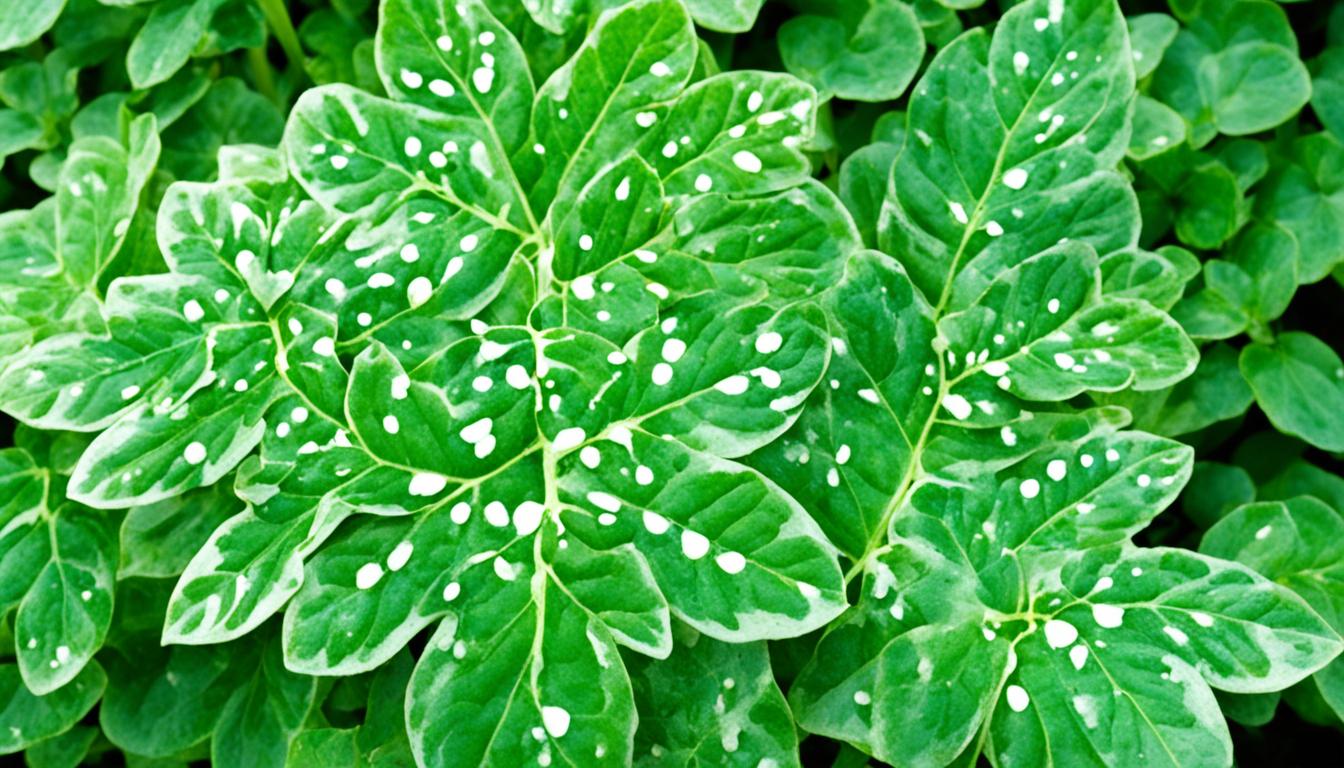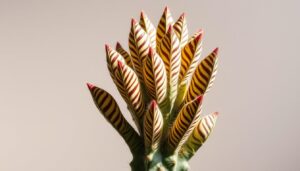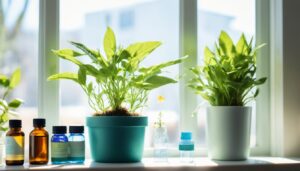Are your indoor plants wilting, discolored, or struggling to thrive? It might not be pests or disease causing the problem, but a nutrient imbalance. Plant nutrient deficiencies can show up in many ways. Identifying the specific deficiency is crucial to fixing your plants.
But how do you spot these signs and fix them? This guide will show you how to bring your indoor plants back to life.
Nutrient deficiencies in plants can be tricky to figure out. But with the right knowledge, you can solve the problem and make your plants healthy again. What signs should you look for, and how can you fix them? This article will give you the answers you need.
Understanding Nutrient Deficiencies in Plants
Healthy plants need the right mix of nutrients to grow well. If the soil or nutrient solution lacks essential nutrients, plants can show nutrient deficiencies. These often appear as leaf color changes and shapes that are not right. It’s common for plants to have more than one nutrient deficiency in plants at once.
What are Nutrient Deficiencies?
Nutrient deficiencies happen when plants don’t get enough of the nutrients they need to grow and develop well. These include macronutrients like nitrogen, phosphorus, and potassium, and micronutrients like iron, zinc, and boron. Without the right balance of these plant nutrient deficiencies symptoms, plants can’t make food, grow, or reproduce right.
Common Symptoms of Nutrient Deficiencies
The signs of nutrient deficiencies can look different, but some common ones are:
- Stunted or slow growth
- Yellowing, wilting, or discolored leaves
- Leaf curling or cupping
- Purple, red, or brown leaf edges or veins
- Poor flowering or fruit production
Many of these signs can look the same, so watch your plants closely. Make sure to check for pests, diseases, or stress before thinking it’s a nutrient issue. Getting help from a gardening expert can also help you figure out and fix plant nutrient deficiencies symptoms.
| Nutrient | Deficiency Symptoms |
|---|---|
| Nitrogen (N) | Yellowing of older leaves, stunted growth, poor vigor |
| Phosphorus (P) | Purple or reddish leaves, delayed maturity, poor root development |
| Potassium (K) | Leaf edges and tips turning yellow or brown, reduced drought tolerance |
Knowing the nutrient deficiencies symptoms your plants show is key to fixing any nutrient imbalances and helping them get back to health.
Identifying and Treating Macronutrient Deficiencies
For indoor plant lovers, knowing the signs of macronutrient deficiencies is key. These include nitrogen, phosphorus, and potassium, which are vital for plant health. Spotting these deficiencies early helps you fix them quickly.
Nitrogen Deficiency in Plants
Nitrogen deficiency often leads to slow growth, yellow leaves, and a dull look. Nitrogen helps make chlorophyll, which keeps leaves green. Without enough nitrogen, leaves turn pale or yellow.
Phosphorus Deficiency in Plants
Phosphorus aids in strong roots, flowers, and fruit. Phosphorus deficiency shows as slow growth, purple leaves, and late or small flowers. Leaves may also become dry and curl inwards.
Potassium Deficiency in Plants
Potassium deficiency makes leaves turn yellow or brown at the edges and tips. They might look scorched or wilted. Potassium helps with water and nutrient intake and fights diseases.
To fix these issues, you might need to change your fertilizer or use supplements. Making sure the soil’s pH and conditions are right is also key for nutrient absorption and growth.
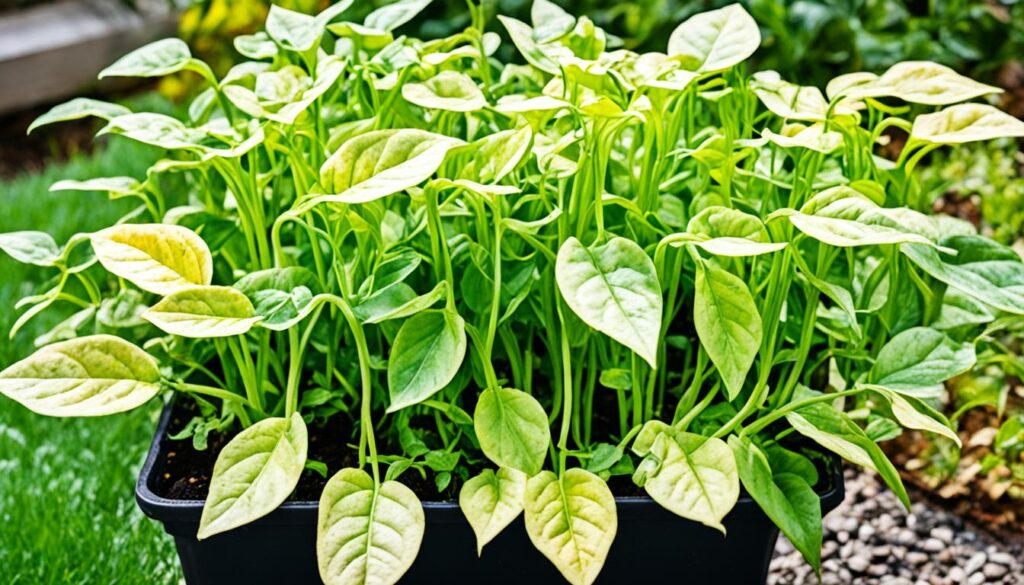
plant nutrient deficiencies symptoms
As a plant lover, knowing how to spot nutrient deficiencies in your indoor plants is key. By recognizing the signs, you can fix the problem fast and help your plants grow strong. Let’s look at the visual signs that show your plants need more nutrients.
Common Nutrient Deficiency Symptoms
- Yellow Leaves: Yellow leaves, especially along the veins or starting from the older leaves, can mean a lack of nitrogen, magnesium, or sulfur.
- Discolored Foliage: Leaves that look purple, red, or blue might show a phosphorus shortage.
- Stunted Growth: Slow-growing plants or those that look bushy could be short on potassium or calcium.
- Leaf Scorch: Browning or burning of leaf edges and tips might mean boron, calcium, or magnesium is lacking.
- Yield Differences: If your plants make fewer flowers or fruits than usual, they might not have enough essential nutrients.
Remember, these signs can also be caused by pests, diseases, or stress. Before adding nutrients, make sure to check for other problems by observing and troubleshooting carefully.
“Properly diagnosing and addressing nutrient deficiencies is key to maintaining the health and vitality of your indoor plants.”
By keeping an eye out and knowing the plant nutrient deficiencies symptoms, you can help your indoor plants do well. With the right nutrients, you can have plants that are lush, vibrant, and full of life.
Micronutrient Deficiencies: Signs and Solutions
Indoor plants need smaller amounts of micronutrients like iron and zinc, besides the big three: nitrogen, phosphorus, and potassium. Not getting enough of these can cause problems that hurt your plants’ health and growth.
Iron Deficiency in Plants
Iron deficiency is a common issue in plants. It shows up as chlorosis, making leaves turn yellow between the veins but keeping the veins green. Iron helps make chlorophyll, which lets plants use sunlight for photosynthesis. Without enough iron, plants grow slow and look weak.
Zinc Deficiency in Plants
Zinc deficiency can make leaves small and misshapen, slow down growth, and cause leaves to bunch up at the plant’s base. Zinc is key for many enzymes and growth hormones in plants. Fixing zinc deficiency plant symptoms is important for healthy plants.
To fix these issues, try adding chelated supplements or changing your soil’s pH to help plants absorb nutrients better. With proper care, you can quickly fix these problems and make your indoor plants flourish.
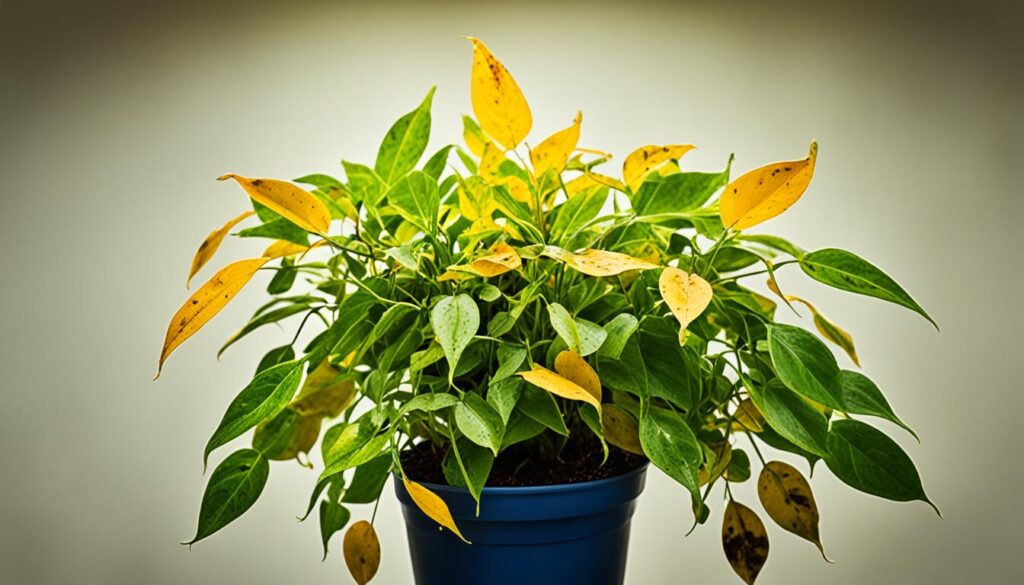
Preventive Measures for Healthy Plant Growth
To keep your indoor plants healthy, you need to act early. Understanding how to stop nutrient shortages is key. Let’s look at some steps to keep your plants looking great.
Checking your soil often is a must. Make sure the pH levels are right to give your plants the nutrients they need. Also, use a good potting mix made for indoor plants to help them grow well.
Having a regular fertilizing plan is also smart. Pick the right fertilizer, whether it’s organic or synthetic, and use it as directed. This helps your plants get the nutrients they need.
It’s important to watch the water your plants get. Make sure they have the right amount of water and use filtered or purified water. This helps avoid mineral imbalances that can cause nutrient shortages.
By taking these steps, you can make a great place for your indoor plants to grow. With a bit of care, you can enjoy the beauty and benefits of healthy, green plants.
Remember, stopping nutrient shortages and helping your plants grow strong comes from caring for them well. Keep an eye on and adjust the environment to help your plants succeed for a long time.
Conclusion
Dealing with nutrient deficiencies in indoor plants can be a fun challenge. By knowing the common signs and how to fix them, you can make your plants healthy and full of life. With careful attention, patience, and the right growing conditions, you can fix nutrient deficiencies and have healthy indoor plants all year.
Every plant is different, so what works for one might not work for another. Keep an eye on your plants’ needs and try different things until you find what works best. With the right knowledge and some trial and error, you can become great at fixing nutrient deficiencies and growing healthy indoor plants that make your space beautiful and lively.
As you keep learning about indoor plant care, enjoy the process, celebrate your wins, and don’t get down about the tough times. Your hard work in taking care of these plants will pay off with beautiful, green plants that make your home better and lift your spirits. Happy gardening!
FAQ
What are the most common nutrient deficiencies in indoor plants?
Indoor plants often lack nitrogen, phosphorus, potassium, magnesium, iron, and calcium. These shortages can cause leaves to turn yellow, growth to slow, and colors to fade.
How can I identify nutrient deficiencies in my indoor plants?
Look for signs like leaf discoloration and growth issues. Make sure pests, diseases, and environmental factors aren’t to blame before pinpointing nutrient deficiencies.
How do I treat macronutrient deficiencies in my indoor plants?
For issues like nitrogen, phosphorus, and potassium, adjust your fertilizer or use supplements. The right pH and growing conditions also play a part in fixing these imbalances.
What are the signs of micronutrient deficiencies in indoor plants?
Iron and zinc deficiencies show as yellowing leaves with green veins, stunted growth, and misshapen leaves. Fixing this often means adding chelated supplements or tweaking the soil’s pH.
How can I prevent nutrient deficiencies in my indoor plants?
Keep an eye on soil type, water quality, temperature, and pH. Regular checks and adjustments help your plants get the nutrients they need. Using good potting mix and a proper fertilizing schedule also keeps plants healthy.


